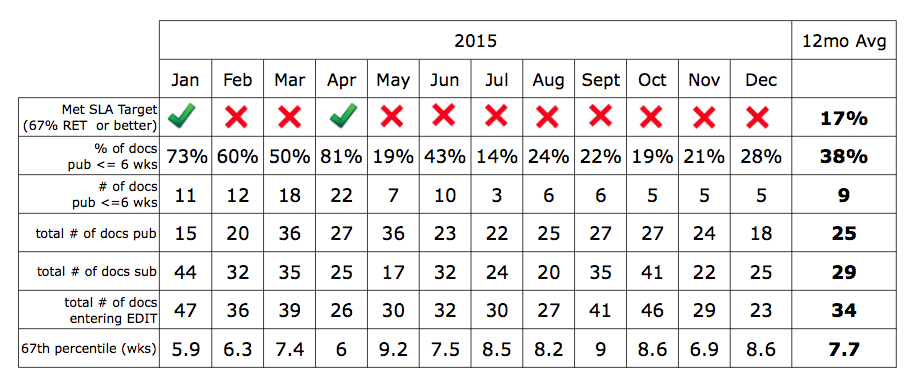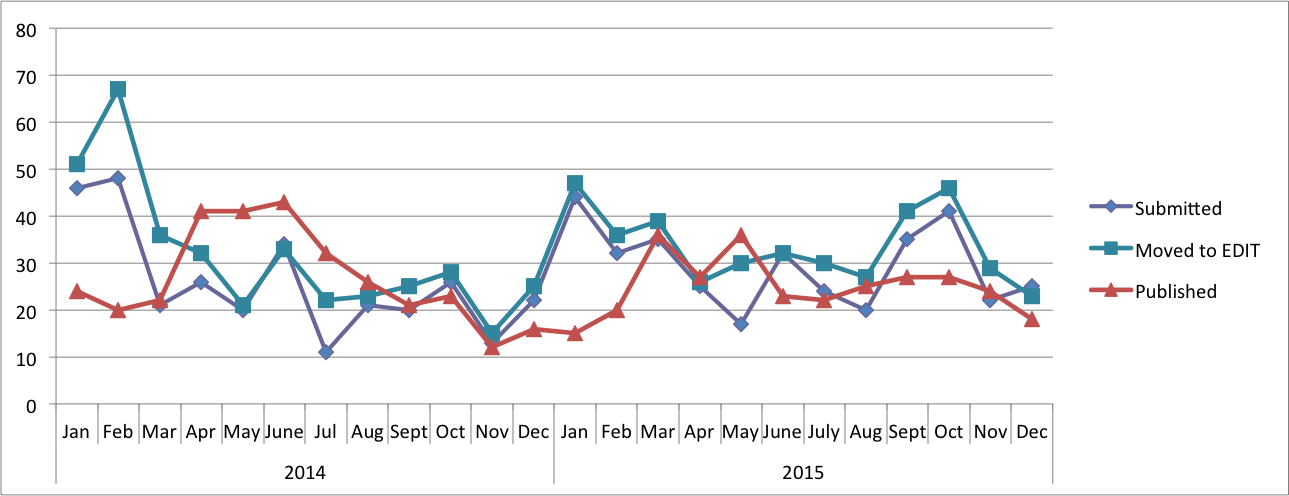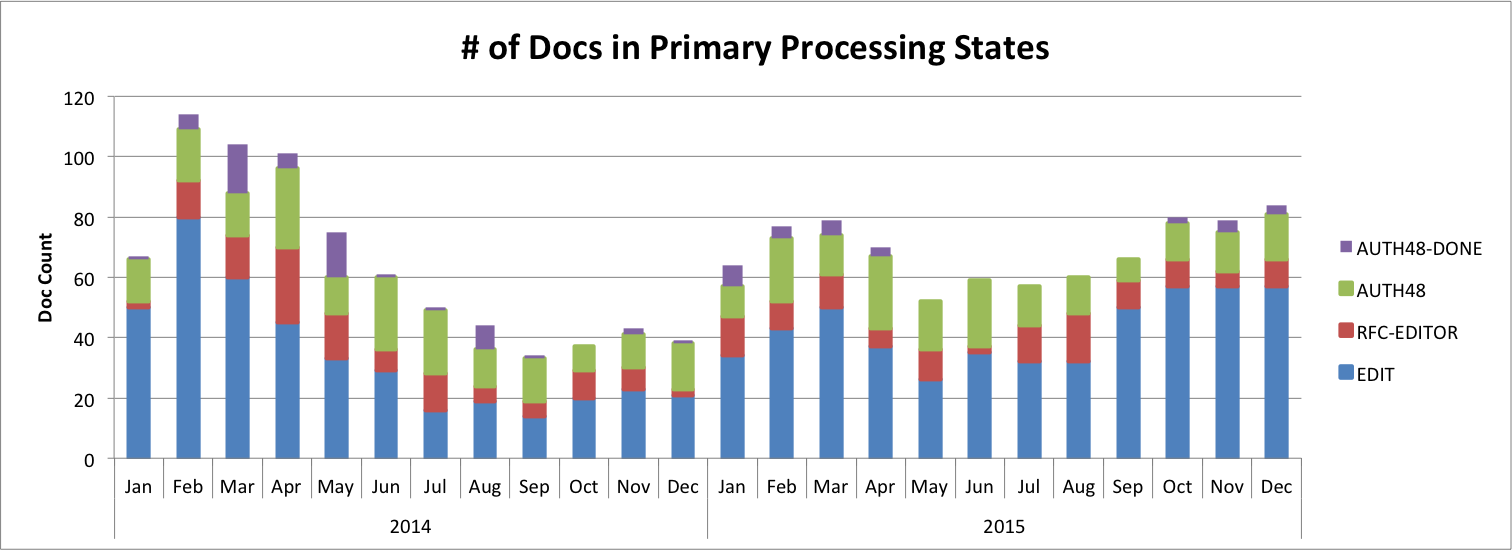Report Summary 2015
This page contains useful information regarding the performance of the RFC Production Center (RPC). It includes news items (updated as needed) and stats about production that are updated on a monthly basis.
The RFC Editor strives to provide excellent and timely editorial service. To ensure the RFC Editor is providing the best possible service, the RPC regularly reviews its processes and liaises with the communities served. In addition, the rfc-interest mailing list is dedicated to discussing topics related to the RFC Editor.
Table of Contents
Service Level Agreements
The Service Level Agreement indicates that 67% of the documents should be published with an RFC-Editor time (RET) of 6 weeks or less. The following table indicates whether we are meeting this goal. It also includes a running 12-month average. Note that pre-2014 SLA monthly reports are available in the reports archive.

Notes
December 2015: Throughout the year, about 40% of the documents published had an RET of 6 weeks or less. Publications have been pretty steady throughout the year, with an average of 25 RFCs being announced per month. However, the submission and “moved to EDIT” rates have been bursty and have been higher than usual. For 2015, the submission count (352 documents) was the highest it’s been since 2011 (364 documents, which is the record for the RFC series). This has made it difficult to keep up with the expected processing times. See the graphs below for more details about the submission bursts and the number of documents in the various processing states.
October 2015: The RPC released the new RFC Editor website and monitored feedback. In the latter half of the month, staff prepared for IETF 94 in Yokohama, Japan.
September 2015: The legal inquiries mentioned in August were resolved with declarations (i.e., a deposition was not required). See the IAOC’s subpoenas page for details. Staff also prepared for the transition to the new RFC Editor website set to be released October 1.
August 2015: In addition to the usual document processing, the RFC Editor has been working on responses to two legal inquiries, one of which will likely require a deposition.
July 2015: Typically, the rate of input to the queue (i.e., documents moved to EDIT) decreases following the Q1 burst; however, we have not seen the usual dip which means processing continues to be impacted.
A document legal inquiry was received, as posted on the IAOC’s subpoenas page.
June 2015: There have been and continues to be a significant number of complex clusters in play in 2015 (documents from another 3 clusters were published this month).
A document legal inquiry was received, as posted on the IAOC’s subpoenas page.
May 2015: We are seeing a significant impact on the RFC Editor processing times as several clusters make their way to publication. Cluster 241 (C241), the jose/oauth cluster of 9 documents, was published as well as RFCs from eight other clusters. Of the documents published this month, 58% were associated with a cluster. Processing time for cluster documents are usually longer as the editors work through consistency issues within the cluster.
March 2015: The table above is showing the impact of the Q1 surge in submissions on the processing times. In addition, a number of large and complex clusters are making their way through the queue.
February 2015: The Q1 surge continued in February, with 36 documents being released into EDIT. The RPC continues to work their way through the surge and the clusters released in January. We just missed the SLA, as 67% of the RFCs were published in 6.3 wks.
January 2015: The RFC Editor is experiencing the typical surge associated with the March IETF meeting (IESG changeover); the number of submissions has increased significantly this month. In addition, sizable clusters were released into the EDIT queue, e.g., weirds (C240), which includes 5 documents, and jose/oauth (C241), which includes 9 documents.
Monthly Submission and Publication Stats
The following figures show the recent submission and publication rates. The figures also include “moved to EDIT”, which provides a more accurate picture of the RPC’s incoming workload for a given month. “moved to EDIT” refers to documents that were released into the EDIT state.
Detailed submission and publication data can be found on the Comprehensive Sub/Pub Stats page.
Notes
September & October 2015: As seen in the graph, there was an second influx of document submissions and documents moved to EDIT. The first surge started in January (just prior to IETF 92); the second surge started in September (just before IETF 94).
July 2015: While the graph shows just over 30 documents moving to EDIT state, the page count is equivalent to 43 average-sized documents.
May 2015: While the submission rate dropped, the number of documents released into the EDIT queue was more similar to a typical submission month.
April 2015: The submission rate returned to normal in April and a couple of the smaller clusters exited the queue.
March 2015: The Q1 surge continues, as another 39 documents were released into the EDIT queue. Publications increased in March, as clusters C182, C184, C232, and C240 exited the queue.
February 2015: The Q1 surge continues in February, as 36 documents were released into the EDIT queue. Publications have been since November, but 26 documents were moved to RFC-EDITOR state and 29 were moved to AUTH48 this month. The team has been working on clusters, so we will see an increase in publications once the clusters have worked their way through AUTH48.
January 2015: As noted above, we are experiencing a surge in submissions this month; the size is similar to the increase we saw in January 2014.
November & December 2014: This graph shows the rate of documents entering and exiting the queue over the last 24 months. We see that there was a spike of documents entering EDIT in January, with increased publication rates in April – June. The publication rates were down in November and December, as we often see a slower response times between authors and editors, as many are on vacation during the winter holidays.
October 2014: There was a slight increase in submissions this month, as compared to the last few months.
August and September 2014: The RPC published slightly more RFCs than the number that were released into the EDIT queue, resulting in a further reduction in the total number of documents in the queue.
July 2014: The RPC had another sizable publication month, so the queue size has continued to decrease.
June 2014: The last three months have been big publication months. As can be seen, the size of the overall queue and the number of documents in EDIT continues to decrease. The decrease in queue size indicates that the RPC is working through the queue.
May 2014: April and May have been big publication months. We have seen a steady decline in the number of documents moving to EDIT since February. The increase in publications is an indication that the RPC is starting to work its way through the burst of documents that entered the queue earlier this year.
April 2014: The graph shows that, while submissions are down, the number of documents entering EDIT has not slowed as is typical post IESG changeover. 64% of the documents that moved into EDIT in 2013 have already been released to EDIT in the first 4 months of 2014.
Queue Statistics
Summary of queue statistics about the processing times of documents as they move through the RFC Editor queue are available on the Queue Summary page. The summary includes document counts, page counts, and average times in queue per state (EDIT, RFC-EDITOR, AUTH48, and AUTH48-DONE). See state definitions for help understanding the states.
The number of documents in the primary processing states (i.e., those that
cannot be held by a third party) at the end of a given month is shown in the figures below.
Note that there is a ripple effect, as spikes in document counts in any one state may be due to clusters of documents moving through the queue together. A cluster does not move to the next state until the entire set is ready to be moved. You will often see bursts in EDIT, then RFC-EDITOR, and finally PUB, as the set of documents move through the states together to publication.
Generally speaking, the more documents there are in the queue, the longer it takes for documents to move through the queue.
Notes
October 2015: As noted above, there was a large burst in document submissions in September and October, which results in a larger overall queue size.
September 2015: The total number of documents in these actionable states has remained steady over the last three months (around 60). As seen above, the number of documents entering EDIT has continued to be high.
May 2015: The total number of documents in these actionable states continues to decrease. However, many of these documents are part of clusters, which require more editorial time.
April 2015: The figure shows that we’re making progress in working through the Q1 surge, as the number of documents in EDIT is declining. In addition, 34% of the documents counted in one of the active states above are in AUTH48 and nearing publication.
March 2015: As noted above, a number of clusters exited the queue, reducing the number of documents in AUTH48. The RPC is working its way through EDIT, which is slower than usual as the editors continue to work through a number of clusters (there are currently six different clusters in EDIT).
February 2015: With the Q1 surge underway, the EDIT queue has grown. The number of documents in AUTH48 has also increased as some of the clusters are making their way to AUTH48.
January 2015: While the surge of incoming documents was big, the number of documents in various states is more evenly distributed than it was in January 2014.
December 2014: The majority of documents in the queue are in the EDIT and AUTH48 states. A few clusters were released into the EDIT queue, including a 300+ page NFS document, which is part of C182.
November 2014: Because of the time the RPC invested in preparing for IETF and for the Experimental Writing Lab sessions, we saw a slight increase in the EDIT queue this month.
October 2014: With the slightly increased submission rates noted above, the EDIT queue has increased slightly as well.
August and September 2014: As can be seen in the graph, the RPC has continued to work its way through the huge surge experienced earlier this year, which cuts the queue size by more than 50% from its peak in February.
July 2014: As can be seen in the graph, the RPC has continued to work its way through the huge surge experienced earlier this year. The queue size has continuously declined since its peak in February.
June 2014: The number of documents submitted to the queue and entering EDIT since December 2013 have remained high. While May was a low submission month, submission numbers were again high in June. The RPC is starting to make headway in to the queue, as we see the third big publication month in a row.
May 2014: This figure shows that, since February, there has a steady decline in the number of documents in EDIT and the overall queue.
April 2014: The figure shows that the number of documents in EDIT has gone down consistently in March and April. The number of documents in RFC-EDITOR and AUTH48 has grown, which is largely due to the clusters currently in these states (i.e., most of C160 in RFC EDITOR, and the following clusters in AUTH48: a portion of C160, as well as C199, C203, C218, C222).
Other Reports
| Report | Description |
|---|---|
| Current Queue (sortable) | A list of all of the documents in the RFC Editor queue, ordered by state. (Updated dynamically) |
| Queue Summary | RFC Editor queue summary (Updated weekly) |
| Reports Archive | Pre-2014 reports (Was updated monthly) |
| State Changes by Month | Summary of document movement through the RFC Editor queue. (Updated weekly) |
| Annual Publication Rate | Bar graph showing the number of RFCs published per year since 1969. (Updated annually). |
| RFC Editor Reports at IETF | Summary of the RFC publication process, including the state of the queue and a breakdown of the reasons for any long delays in the publication process. The report also may include recent changes in policy and improvements in tools or procedures. (Updated quarterly) |
| RFC Errata Reports | Summary of errata reports and their status, stream, and type. (Updated quarterly) |
| RFC Status Changes (post-publication) | List of the RFCs whose statuses have changed since publication. (Updated as needed) |
This page is archived annually; see 2014.


